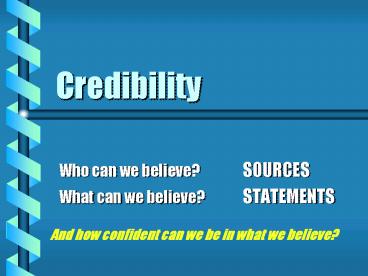Credibility - PowerPoint PPT Presentation
1 / 9
Title:
Credibility
Description:
There is no simple rule for assessing credibility. Assessing credibility requires judgment. ... Judgment depends on background knowledge. Judgments of ... – PowerPoint PPT presentation
Number of Views:77
Avg rating:3.0/5.0
Title: Credibility
1
Credibility
- Who can we believe? SOURCES
- What can we believe? STATEMENTS
And how confident can we be in what we believe?
2
Assessing Credibility
There is no simple rule for assessing credibility.
Assessing credibility requires judgment.
Judgment depends on background knowledge.
Judgments of credibility are basically inductive.
Assessing credibility is a matter of "more or
less" -- probabilities expressed as gradations.
3
Gradations of Credibility
- All-or-nothing a false dilemma
A false dilemma presents two choices as though
they were the only options, e.g., simply believe
or don't, when in fact, other options exist,
e.g., proceed with caution. The factor of
confidence is important in how we follow up
acceptance or non-acceptance (including
rejection) of a proposition.
4
Gradations of Credibility
- All-or-nothing a false dilemma
- Once-and-for-always false confidence
The history of an individual or an idea counts
for a lot in determining credibility, but people
and conditions both change. So, credibility may
go up or down. And it may do so incrementally or
as a sudden reversal.
5
Gradations of Credibility
- All-or-nothing a false dilemma
- Once-and-for-always false confidence
- Intuitions, feelings, and logic
It is important to use all of our resources in
determining credibility. But it's important to
differentiate what helps focus attention from
what counts toward making a decision.
Intuitions and feelings generally precede logic.
6
Assessing content of a statement
- Role of personal observation
Focus of attention Preparedness for
distinguishing features Conditions of
observation Expectations, beliefs, biases
7
Assessing content of a statement
- Role of personal observation
- Role of background information
Initial plausibility Novelty and conflict
Extent of background information
8
Assessing content of a statement
- Role of personal observation
- Role of background information
- Arguments in favor and against
May justify high or low confidence in its
truth May presuppose unstated beliefs May
look to future consequences of accepting
9
Credibility of a source
- Knowledge
- Ability
- Motivation
Education and experience both matter.
Physical and mental factors may both be relevant.
Desires, aversions, and beliefs, including
prejudices may work in various ways.































